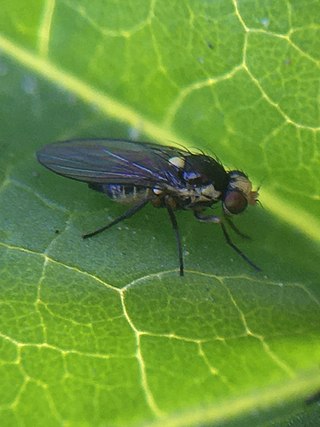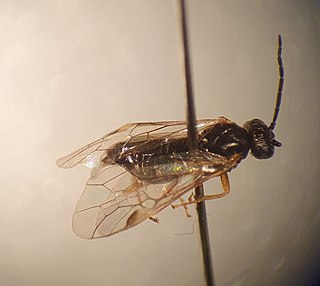
Sawflies are wasp-like insects that are in the suborder Symphyta within the order Hymenoptera, alongside ants, bees, and wasps. The common name comes from the saw-like appearance of the ovipositor, which the females use to cut into the plants where they lay their eggs. The name is associated especially with the Tenthredinoidea, by far the largest superfamily in the suborder, with about 7,000 known species; in the entire suborder, there are 8,000 described species in more than 800 genera. Symphyta is paraphyletic, consisting of several basal groups within the order Hymenoptera, each one rooted inside the previous group, ending with the Apocrita which are not sawflies.

Tenthredinidae is the largest family of sawflies, with well over 7,500 species worldwide, divided into 430 genera. Larvae are herbivores and typically feed on the foliage of trees and shrubs, with occasional exceptions that are leaf miners, stem borers, or gall makers. The larvae of externally feeding species resemble small caterpillars. As with all hymenopterans, common sawflies undergo complete metamorphosis.

Birch leafminers are sawflies, which are closely related to bees and wasps. They are among the most common insect pests affecting birch trees in North America. The primary species affecting birch trees in North America are Profenusa thomsoni and Fenusa pumila. Areas inside the leaves are consumed by the larvae, affecting the leaves' ability to produce food. Yearly browning of birch leaves are noticed in mid July and August, but the leafminers have been feeding inside the leaf tissue since early spring.

Eriocrania semipurpurella is a moth of the family Eriocraniidae, found from Europe to Japan and in North America. It was first described by James Francis Stephens in 1835. The species closely resembles Eriocrania sangii and the larvae of both species mine the leaves of birch.

Xanthogaleruca luteola, commonly known as the elm-leaf beetle, is a beetle species in the family Chrysomelidae that is native to Europe but invasive in other parts of the world.

Pegomya hyoscyami, the beet leafminer or spinach leafminer, is a grey fly about 6 millimetres (0.24 in) long. It emerges in April–May and lays eggs on the undersides of leaves of beet, spinach, chard, and other greens. Eggs develop into larvae that burrow into the leaf hollowing out large patches of the leaf between leaf surfaces, often killing large parts of the leaf.

Eriocrania sparrmannella also known as the mottled purple is a moth of the family Eriocraniidae, found in Europe and Japan. It was first described by the French entomologist, Louis Augustin Guillaume Bosc in 1791. The specific name honours the Swedish naturalist Anders Erikson Sparrman. The larvae mine the leaves of birch.

Phyllonorycter apparella, the aspen leaf blotch miner moth, is a moth of the family Gracillariidae. It is found in most of Europe. It is also present in Turkey and North America.

Craesus septentrionalis, the flat-legged tenthred or birch sawfly, is a species of insect in the order Hymenoptera, the suborder Symphyta and the family Tenthredinidae. It was first described by Carl Linnaeus in 1758. The adult sawflies are black and brown with transparent wings and the larvae are yellowish-green and resemble caterpillars. The larvae feed on the leaves of various species of deciduous tree.

Monostegia is a genus of sawfly. The authority is based on the description by Achille Costa and Oronzio Costa, although earlier work grants this to Fabricius 1798., though the most common species, M. abdominalis, bears the authority of Fabricius.
Tomostethus multicinctus, the brownheaded ash sawfly, is a species of sawfly in the family Tenthredinidae that is native to southern Canada and the eastern United States. Adults of this species resemble wasps and the larvae feed on the leaves of ash trees.
Liriomyza sativae, commonly known as the vegetable leaf miner, is a species of insect, a fly in the family Agromyzidae. The larvae of this fly mine the leaves of a range of vegetables and weeds, but seem to favour plants in the families Cucurbitaceae, Fabaceae and Solanaceae.

Liriomyza huidobrensis, commonly known as the pea leaf miner, is a species of insect, a fly in the family Agromyzidae. The larvae of this fly mine the leaves and stems of peas and a range of other vegetables. It is also known as the serpentine leaf miner, but this name is also used for a closely related species, Liriomyza brassicae.

Eriocampa ovata, known generally as the alder sawfly or woolly alder sawfly, is a species of common sawfly in the family Tenthredinidae. The larvae feed on the leaves of the common alder and the grey alder, sometimes causing defoliation.

Euura proxima is a species of sawfly belonging to the family Tenthredinidae. The larvae feed on the leaves of willows, creating galls. It was described by Jean Guillaume Audinet-Serville in 1823. The species was placed in the genus Euura in 2014 and was previously known as Nematus proximus and Pontania proxima.
Euura bridgmanii is a species of sawfly belonging to the family Tenthredinidae. The larvae feed on the leaves of sallows. It was first described by the entomologist Peter Cameron in 1883.
Euura vesicator is a species of sawfly belonging to the family Tenthredinidae. The larvae feed internally in a gall on the leaves of purple willow and its hybrids. It was first described by Johann Jacob Bremi-Wolf in 1849.

Euura viminalis is a species of sawfly belonging to the family Tenthredinidae. The larva feed within galls on the leaves of willows. It was first described by Carl Linnaeus in his landmark 1758 10th edition of Systema Naturae.
Lathrolestes luteolator is a species of wasp in the family Ichneumonidae. It is native to North America and is a parasitoid of various species of sawfly larvae. In the 1990s, it started to parasitise the larvae of the invasive amber-marked birch leaf miner in Alberta. When this pest spread to Alaska, the wasp was used in biological pest control.
Simacauda dicommatias is a moth of the family Incurvariidae found in South America. It was described by the English amateur entomologist, Edward Meyrick in 1931. The larvae are leaf miners and feed within the leaves of Chilean myrtle. In 2020 leaf mines were found at Trengwainton Garden, Cornwall; the first known occurrence in Europe.














